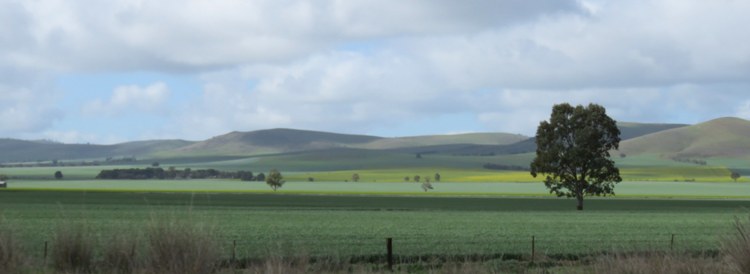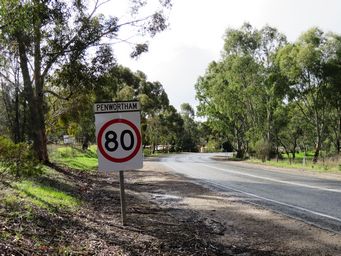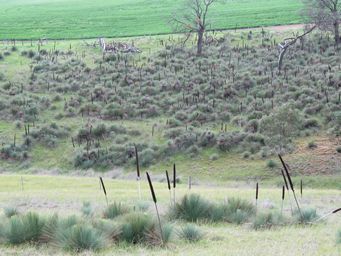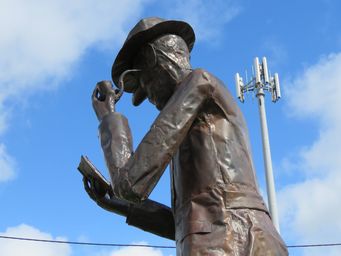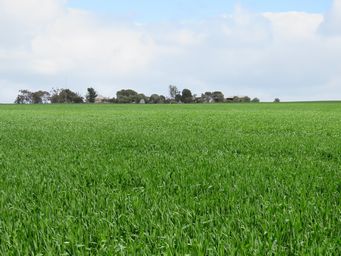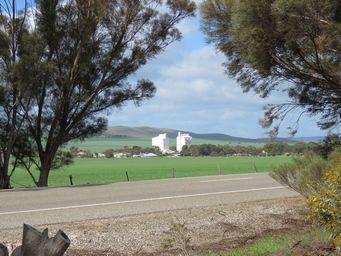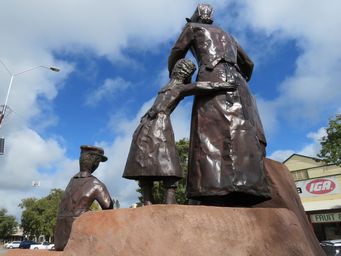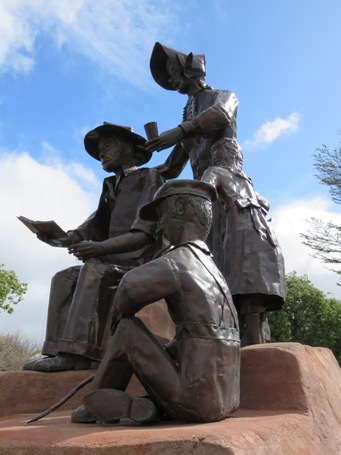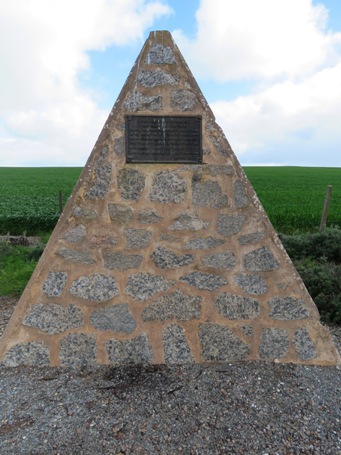Australia So Much to See
Heading into the Clare Valley
CJ Dennis 1876 - 1938
Creator of "The Sentimental Bloke" and other verses
Australia’s most prolific poet
Born Auburn South Australia
Resided
at Laura during his formative years
Sculpture by Dave Griffiths (Adelaide)
Concept design by Dick Biles
Erected in front of
Biles Art
Gallery" Laura, Jubilee year 1986
Kindly gifted to the town of Laura by
Richard "Dick" Biles (Laura) 2011
We passed the ruins of the Laura Flour Mill. Originally built in 1874, it was rebuilt in 1878 following a fire. Laura
was known for producing a high quality flour. The flour mill ceased operations in 1970, and in 2015 suffered extensive damage
from an arson attack.
Early industries in Laura included a butter factory, and a dairy cooperative which became the Golden North
Ice-cream factory. During the second world war, flax was grown in the area and milled in Laura.
C. J. Dennis was born in Auburn, South Australia. His father owned
hotels in Auburn, and then later in Gladstone and Laura. His mother suffered ill health, so Clarrie (as he was known) was raised initially
by his great aunts, then went away to school, Christian Brothers College, Adelaide as a teenager.
At the age of 19 he was employed
as a solicitor's clerk. It was while he was working in this job that, like banker's clerk Banjo Paterson before him, his first poem
was published under the pseudonym "The Best of the Six". He later went on to publish in The Worker, under his own name, and
as "Den", and in The Bulletin. His collected poetry was published by Angus & Robertson.
He joined the literary staff of The
Critic in 1897, and after a spell doing odd jobs around Broken Hill, returned to The Critic, serving for a time c. 1904 as editor,
to be succeeded by Conrad Eitel. In 1906 he founded The Gadfly as a literary magazine; it ceased publication in 1909. From
1922 he served as staff poet on the Melbourne Herald.
John Ainsworth Horrocks
Pastoralist and Explorer
Passed through this district 1 August 1846 on his expedition to the north west of Mount
Arden.
Gulnare Plain had been named by Horrocks five years previously after a favourite dog.
Horrocks was accidentally wounded 1 September
at Lake Dutton and died 23 September at Penwortham
Erected 1946
John Ainsworth Horrocks (1818-1846), pastoralist and explorer, was born on 22 March 1818 at Penwortham # Lodge, near Preston,
Lancashire, England. He arrived in South Australia in 1839 on his twenty-first birthday
On the advice of Edward John Eyre,
he explored land near the Hutt River, north of Adelaide and established Penwortham village. Other pastoralists followed him into the
area. In 1841 the long awaited special survey gained a frustrated Horrocks title to only some of the fertile land he had been occupying.
Nevertheless, he built up a flock of 9,000 sheep and is believed to have established the first vineyard in the Clare district.
Stone Hut is a tiny village, with only a few houses and their renowned bakery. This must be in a reliable rainfall area, as
every time we have been here, crops have been magnificent.
Reaching Laura, the median strip of the main street had sculptures representing CJ Dennis and his family.
Most rural towns in the Mid North have community managed caravan parks, and many of these have dump points.
The white
of the grain bins at Gulnare stand out in the sun. Just to the north of this grain receival point, there is a memorial to John
Ainsworth Horrocks.
Clare, at the head of the Clare Valley wine region, is a large regional centre. The valley follows through small towns which
very close to each other, being Sevenhill, Penwortham, Watervale, Leasingham, and Auburn.
Laura has a community managed caravan park with full services, and powered sites for two $28. There is a dump point nearby.
Gladstone has a community managed caravan park $28 powered. Dump point close by.
Georgetown has a donation
camping area, with toilets and coin operated showers.
Yacka, community run low cost, amenities, and four powered sites
$15 at Yackamoorundie Park. Dump point.
Brinkworth is five kilometres from the highway and has a community managed
low cost 72 hour caravan park with toilets, showers and power. $12 for power and use of amenities. There is a dump point,
and pets are permitted.
Clare has Racecourse camping on the north side of town at $20, and a more expensive caravan park
on the southern edge of town. Prices for a powered site start at $39 (park on gravel) and $45 for drive through or grassy sites.
Fifteen kilometres south of Clare, a few hundred metres north of Watervale, a rest area utilises a strip of unsealed old road. Some caravanners stop here overnight, although very close to the road.
Leasginham eighteen kilometres south from
Clare has a budget cabin and caravan park, with powered sites $25 (seniors discount $22.50).
Auburn, the birth place of CJ Dennis,
is a further ten kilometres south from Leasingham. The community sportsground campsite is one of the best you will find. $25
powered site.
As the terrain became hilly, we passed the site of the 1896 settlement of Rochester. Nothing remains now.
To the
north of Clare, we passed a patch rich with Xanthorrhoea which have not been cleared making a lovely sight, and are most likely Xanthorrhoea
australis. These are known is Yaccas, Yackas or Yakkas in South Australia, with variable spelling. I always remember
these as being near the small town of Yacka. But the two, both drawn from Aboriginal names, are not closely associated, with
Yackamoorundie, meaning 'sister to the big river', with the township of Yacka being surveyed in 1869 in the area known as Yackamoorundie.
Resources
Australian Dictionary of Biographies – John Horrocks
Northern Areas Council - Yacka
Wikipedia – Penwortham, Lancaster, England
